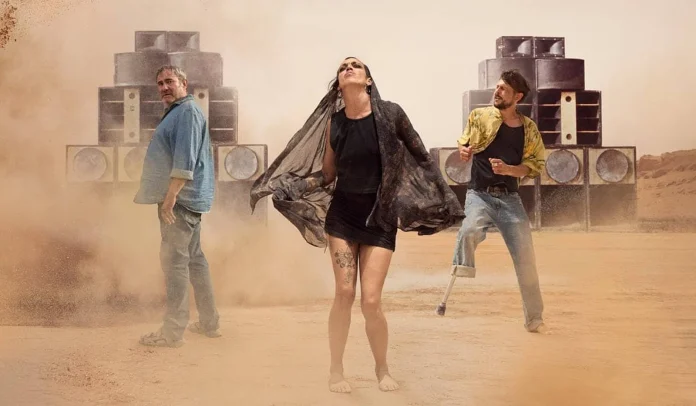After pausing his Moroccan film cycle (Mimosas, You All Are Captains) to shoot Fire Will Come (O Que Arde) in his native Galicia, Paris-born Galician filmmaker Oliver Laxe returns to North Africa with Sirât — an explosive and enigmatic dramatic thriller.
Back in 2019, Laxe told C7nema that the film was inspired by Mad Max, Easy Rider, and Tarkovsky’s Stalker. Set against the stark, otherworldly expanse of the desert and immersed in the pulsating subculture of rave communities, Sirât follows a father’s anguished search for his missing daughter. In a rare move for Laxe — who typically works with non-professional actors — the lead is played by the acclaimed Spanish performer Sergi López. He plays Luis, a man whose face bears the deep etchings of despair. Accompanied by his pre-teen son Estebán (Bruno Nuñez) and their loyal dog Pipa, Luis arrives in Morocco in pursuit of his teenage daughter, who has been missing for more than six months.
Drifting through the chaotic energy of desert raves and among the “technomads” who inhabit them, Luis receives vague reassurances, cryptic suggestions — but never the confirmation he so desperately seeks when showing his daughter’s photograph.
Meanwhile, a global war simmers ominously in the margins. We glimpse it only through fractured radio broadcasts — brief, enigmatic bulletins that offer no real context. Laxe deliberately avoids giving the conflict a clear shape, keeping it amorphous and unsettling. Rather than serving as a narrative driver, the war adds a suffocating layer of unease, intensifying the film’s atmosphere of dread and disorientation.
Luis’s car — a flimsy rental entirely unsuited to the brutal terrain — quickly becomes a burden. The rocky hills, shallow streams, and scorched desert plains prove nearly impassable. His only hope lies in joining a roving group of nomads (Stefania Gadda, Joshua Liam Henderson, Jade Oukid, Richard “Bigui” Bellamy, and Tonin Janvier), fugitives from Moroccan authorities after defying surveillance orders following a rave-site raid.
Fleeing across the desert in two battered vans, Luis and the group form a tenuous but growing bond, pooling their resources and resolve as they make their way toward another underground gathering — one that may finally offer clues to his daughter’s fate.
As in much of Laxe’s work, Sirât blurs the line between fiction and documentary. Whether lingering in the ecstatic stasis of a rave or navigating the shifting momentum of a road movie — even as it veers into a final act steeped in near-hallucinatory horror — the film remains rooted in a tactile sense of presence.
Professional actors like López share the frame with non-actors playing versions of themselves, further dissolving the boundaries between character and self, performance and lived reality. These “technomads” are both products and survivors of a post-capitalist drift, and Laxe infuses them — and the film — with a quiet mysticism and mythic undertow.
Driven by a hypnotic score from Kangding Ray, and unfolding across a landscape as terrifying as it is beautiful, Sirât moves with a swirling, feverish momentum that immerses the viewer in sensory and emotional disorientation — unsettling by design, yet wholly mesmerising.
The title refers to the Islamic concept of as-Sirāt, the bridge between paradise and hell — and that duality is embedded in every frame, a journey across physical and metaphysical thresholds.
In a conversation with C7nema, Laxe described the filmmaker’s role as “somewhere between the terrorist and the saint.” In Sirât, he walks that razor-thin edge with remarkable intensity — leading us through landscapes of anguish and flickering grace, through ruin and redemption, all in a vision impossible to look away from.


